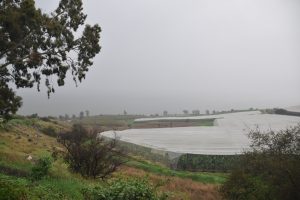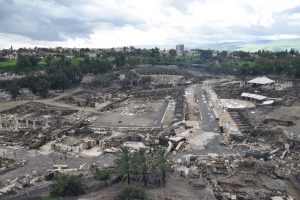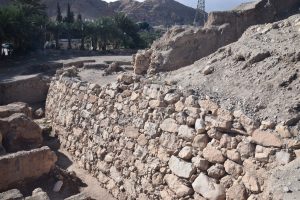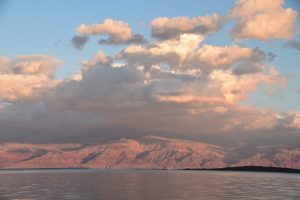DAY 5 – TUESDAY, FEBRUARY 13: MT. OF BEATITUDES, BEIT SHEAN, JERICHO, DEAD SEA
Today we left the Sea of Galilee area and drove south. Our final destination today on a day that started with steady rain through the first part of the morning was the Dead Sea. The weather improved as by late morning, with sun and clouds and highs in the 70s.
Mt. of Beatitudes
Leaving our hotel shortly after 7:30 again, we first drove to the Mt. Of Beatitudes. This was one location where Jesus delivered His sermon on the kingdom principles (this sermon would be His “go-to” message, and He shared it in other places too, see Luke 6:17-49). Overlooking a natural amphitheater and huddling together under umbrellas, we heard part of Matthew 5 in Hebrew and then in English. We enjoyed a time of reflection, song, and prayer. The words of Jesus came alive here in this place!
Kinneret Cemetery
Driving south to the end of the Sea of Galilee, we made a brief “extra” stop at the Kinneret Cemetery. Here Shlomo shared with us about kibbutz life in Israel. We also heard of the story of a Russian/Ukrainian Jew named Rachel Bluwstein. She was an early Jewish pioneer in the land. She is famous for her poems. She died in 1931. Her face is now on the new Israeli 20 shekel bill!
Beth Shean
Continuing south through the Jordan Valley, we arrived at Beth Shean. By the time we started our tour of this site, the rain stopped and the sun came out! Beth Shean was one of Israel’s most extensive archaeological site. It was on the ancient walls of the Old Testament city where King Saul’ body was hung after his death on Mt Gilboa (1 Samuel 31). Beth Shean was also a very large Roman city as well, peaking from the 2nd-5th century AD. We walked on the colonnaded stone pavements/streets, saw Roman bathhouses and many mosaics as well as the agora (market place), public latrenes, and the massive theater. Some in the group climbed to the top of the OT tel for a great view of the Roman city below. Following seeing the site, we had lunch near by.
Jericho
From here we drove a little over an hour south down the Jordan Valley. At the northern end of the Dead Sea is the city of Jericho. This was our last stop of the day. Jericho was the first city taken in Joshua’s Conquest (Joshua 6). We saw the retaining/revetment walls of the city on top of which was a mud-brick wall. It was the later that came tumblin’ down when the shofars (trumpets) were blown (David actually blew a small shofar when we read the story! Just a couple of miles to the south was New Testament Jericho. It served as Herod’s winter palace. It was here where Zacheaus (Luke 19) and Bartemaeus lived (Mark 10). It was also here where Herod the Great died in 4 BC.
Dead Sea
Driving south along the Dead Sea, we enjoyed spectacular visibility. The mountains of Moab (in Jordan) and clouds in the sky were so colorful as the sun began to set. After we arrived at our hotel in Zin Bokek, we changed into our swim suits for a unique float in the Dead Sea. Again the backdrop of the Jordanian mountains was amazing! Following a good hot shower, we enjoyed dinner together and a free evening.






Thank you so much for sharing the events of this trip through word and pictures. My brother and sister-in-law, Ron & LaVonne Anderson, are on this trip so it is so fun to see them enjoying Israel! I am praying for safety for the group and a great time of reflection on each of their lives. Am excited to hear all about the trip when they get home.
Thanks so very much! It was a delight to have them along!
J
Unsubscribe me. Thanks, Wanda
Please unsubscribe me from your emails. Thanks, Wanda Jackson.
Email address is: wjackson112@cableone.net
Sure thing…. I just unsubscribed you.
Blessings and thanks!
J